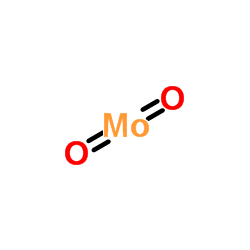18868-43-4
| 中文名 | 二氧化钼 |
|---|---|
| 英文名 | dioxomolybdenum |
| 中文别名 | 氧化钼 |
| 英文别名 |
molybdenum dioxide
MoO2 EINECS 242-637-9 molybdenum oxide Molybdenum, dioxo- Molybdenum(IV) oxide MFCD00014223 Dioxomolybdenum |
| 密度 | 6.47 g/mL at 25ºC(lit.) |
|---|---|
| 分子式 | MoO2 |
| 分子量 | 127.939 |
| 精确质量 | 129.895233 |
| PSA | 34.14000 |
| 外观性状 | 灰色至黑色粉末 |
| 储存条件 | 常温密闭避光,通风干燥惰性气体下 |
| 稳定性 | 常温常压下稳定 避免的物料:氧化物 酸 空气。具有变形的金红石结构,由无限的在相反方向共边的MoO6八面体链组成;Mo—Mo键距的长短沿链的方向交替地变化,长的为0.310nm,短的为0.250nm,它是抗磁性并呈半导体性质,含有金属金属键。具有像铜那样的光泽,是电的良导体。不溶于水、盐酸、氢氟酸、也不溶于碱金属氢氧化物和碱金属碳酸盐的水溶液。因为具有碱性,多多少少能溶解于硫酸中。 |
| 计算化学 | 1.疏水参数计算参考值(XlogP):无 2.氢键供体数量:0 3.氢键受体数量:2 4.可旋转化学键数量:0 5.互变异构体数量:无 6.拓扑分子极性表面积34.1 7.重原子数量:3 8.表面电荷:0 9.复杂度:18.3 10.同位素原子数量:0 11.确定原子立构中心数量:0 12.不确定原子立构中心数量:0 13.确定化学键立构中心数量:0 14.不确定化学键立构中心数量:0 15.共价键单元数量:1 |
| 更多 | 1. 性状:呈紫色或棕色。 2. 密度(g/mL,25/4℃):4.696 3. 相对蒸汽密度(g/mL,空气=1):不确定 4. 熔点(ºC):不确定 5. 沸点(ºC,常压):不确定 6. 沸点(ºC, 5.2kPa):不确定 7. 折射率:不确定 8. 闪点(ºC):不确定 9. 比旋光度(º):不确定 10. 自燃点或引燃温度(ºC):不确定 11. 蒸气压(kPa,25ºC):不确定 12. 饱和蒸气压(kPa,60ºC):不确定 13. 燃烧热(KJ/mol):不确定 14. 临界温度(ºC):不确定 15. 临界压力(KPa):不确定 16. 油水(辛醇/水)分配系数的对数值:不确定 17. 爆炸上限(%,V/V):不确定 18. 爆炸下限(%,V/V):不确定 19. 溶解性:不确定 |
|
Section 1: Product Identification Chemical Name:Molybdenum (IV) oxide, 99% CAS Registry Number:18868-43-4 Formula:MoO2 EINECS Number:242-637-7 Chemical Family:metal oxide Synonym:Molybdenum dioxide, Molybdenous oxide.
Section 2: Composition and Information on Ingredients IngredientCAS NumberPercentACGIH (TWA)OSHA (PEL) Title Compound18868-43-4100%10mg/m3 (as Mo-15mg/m3 Section 3: Hazards Identification Emergency Overview:May be irritating to skin and eyes and respiratory tract. Primary Routes of Exposure:Ingestion, inhalation Eye Contact:May be a mild to severe irritant to the eyes. Skin Contact:May cause slight to mild irritation of the skin. Inhalation:Do not breath dust. Inhalation of powder may lead to irritation of the respiratory tract. Ingestion:Ingestion may lead to vomiting and diarrhea. Acute Health Affects:May be irritating to skin, eyes, mucous membranes and respiratory tract. Do not breath dust. Chronic Health Affects:No information available on long-term chronic effects. NTP:No IARC:No OSHA:No SECTION 4: First Aid Measures Immediately flush the eyes with copious amounts of water for at least 10-15 minutes. A victim may need Eye Exposure: assistance in keeping their eye lids open. Get immediate medical attention. Wash the affected area with water. Remove contaminated clothes if necessary. Seek medical assistance if Skin Exposure: irritation persists. Remove the victim to fresh air. Closely monitor the victim for signs of respiratory problems, such as difficulty Inhalation: in breathing, coughing, wheezing, or pain. In such cases seek immediate medical assistance. Seek medical attention immediately. Keep the victim calm. Give the victim water (only if conscious). Induce Ingestion: vomiting only if directed by medical personnel. SECTION 5: Fire Fighting Measures Flash Point:not applicable Autoignition Temperature:none Explosion Limits:none Extinguishing Medium:None. Material is non-flammable. Special Fire Fighting Procedures:Non-flammable. No special fire fighting procedures. Hazardous Combustion andNo hazardous combustion or decomposition products. Decomposion Products: Unusual Fire or Explosion Hazards: No unusual fire or explosion hazards. SECTION 6: Accidental Release Measures Spill and Leak Procedures:Small spills can be mixed with vermiculite or sodium carbonate and swept up. SECTION 7: Handling and Storage Handling and Storage:Store in a tightly sealed container. SECTION 8: Exposure Controls and Personal Protection Eye Protection:Always wear approved safety glasses when handling a chemical substance in the laboratory. Skin Protection:Wear appropriate chemical resistant gloves and protective clothing. Ventilation:Material may form a fine dust. If possible, handle the material in an efficient fume hood. If ventilation is not available a respirator should be worn. The use of respirators requires a Respirator Respirator: Protection Program to be in compliance with 29 CFR 1910.134. Ventilation:Material may form a fine dust. If possible, handle the material in an efficient fume hood. Additional Protection:No additional protection required. SECTION 9: Physical and Chemical Properties Color and Form:purple pwdr. Molecular Weight:127.95 Melting Point:no data Boiling Point:no data Vapor Pressure:no data Specific Gravity:6.47 Odor:none Solubility in Water:insoluble SECTION 10: Stability and Reactivity Stability:air and moisture stable solid Hazardous Polymerization:no hazardous polymerization Conditions to Avoid:none Incompatibility:none Decomposition Products:none SECTION 11: Toxicological Information RTECS Data:Subcutaneous (mouse); LD50:318 mg/kg. Carcinogenic Effects:No data available Mutagenic Effects:No data available Tetratogenic Effects:No data available SECTION 12: Ecological Information Ecological Information:No information available SECTION 13: Disposal Considerations Disposal:Dispose of according to local, state and federal regulations. SECTION 14: Transportation Shipping Name (CFR):Non-hazardous Hazard Class (CFR):NA Additional Hazard Class (CFR):NA Packaging Group (CFR):NA UN ID Number (CFR):NA Shipping Name (IATA):Non-hazardous Hazard Class (IATA):NA Additional Hazard Class (IATA):NA Packaging Group (IATA):NA UN ID Number (IATA):NA SECTION 15: Regulatory Information TSCA:Listed in the TSCA inventory. SARA (Title 313):Title compound not listed. Second Ingredient:none SECTION 16 - ADDITIONAL INFORMATION N/A |
|
毒理学数据: 急性毒性:小鼠皮下注射LD50:318 mg/kg 生态学数据: 通常对水体是稍微有害的,不要将未稀释或大量产品接触地下水,水道或污水系统,未经政府许可勿将材料排入周围环境。 CHEMICAL IDENTIFICATION
HEALTH HAZARD DATAACUTE TOXICITY DATA
|
| 个人防护装备 | dust mask type N95 (US);Eyeshields;Gloves |
|---|---|
| 危害码 (欧洲) | Xn |
| 风险声明 (欧洲) | R20/21/22 |
| 安全声明 (欧洲) | 26-36 |
| 危险品运输编码 | NONH for all modes of transport |
| WGK德国 | 1 |
| RTECS号 | QA4688000 |
| 海关编码 | 2825700000 |
| 海关编码 | 2825700000 |
|---|


